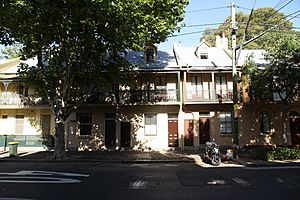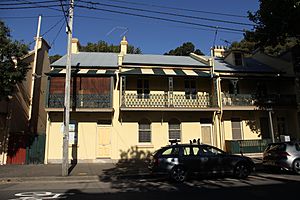Blyth Terrace facts for kids
Quick facts for kids Blyth Terrace |
|
|---|---|

Part of Blyth Terrace, at left, and 90-92 Kent Street, at left, pictured in 2019.
|
|
| Location | 82, 84, 86, 88 Kent Street, Millers Point, City of Sydney, New South Wales, Australia |
| Built | c. 1850s |
| Architect | Fowell & McConnel |
| Architectural style(s) | Victorian Filigree |
| Official name: Blyth Terrace; AMA House | |
| Type | State heritage (built) |
| Designated | 2 April 1999 |
| Reference no. | 839 |
| Type | Terrace |
| Category | Residential buildings (private) |
| Builders | Messrs Hutcherson Bros |
| Lua error in Module:Location_map at line 420: attempt to index field 'wikibase' (a nil value). | |
Blyth Terrace is a special group of old houses in Millers Point, a historic part of Sydney, Australia. These houses are called "terrace houses" because they are built side-by-side in a row. They are located at 82-88 Kent Street.
These homes were designed by Fowell & McConnel and built by Messrs Hutcherson Bros. They are also known as AMA House. Blyth Terrace is very important because it is "heritage-listed." This means it's protected by law due to its historical value. It was added to the New South Wales State Heritage Register on April 2, 1999.
Contents
A Look Back in Time
Millers Point is one of the very first places where European settlers lived in Australia. It has always been a busy area for ships and port activities.
The houses at Blyth Terrace were built around the 1850s. This makes them quite old and a great example of architecture from that time. The NSW Department of Housing started renting out these homes in 1982.
What Blyth Terrace Looks Like
Blyth Terrace houses are two storeys tall. Each house has four bedrooms, a small extra room called a "sleep-out," and an attic space at the very top.
They have some cool features that show their old style:
- A curved verandah (a covered porch) made of wavy iron. It used to be painted with wide stripes.
- An iron lace balcony on the second floor.
- Fancy iron columns supporting the balcony.
- A spear-shaped fence at ground level.
The ground floor has a large window and a front door with a decorative "fanlight" window above it. On the upper level, there are two "French doors" that open onto the balcony. All the windows have shutters.
The houses are built with painted brick walls and have roofs made of corrugated iron. The style of these buildings is known as "Victorian Filigree." This means they have lots of delicate, decorative ironwork, like the lace on the balcony.
The outside of the property is in good condition, showing how well it has been kept over the years.
Changes Over Time
Some small changes have been made to the outside of the houses. For example, some of the original iron columns were removed at some point. The last time the property was officially checked was on February 19, 1995.
Why Blyth Terrace is Special
Blyth Terrace is important because it's part of a group of buildings that look like they belong together on the street. It helps create a consistent look for the area.
It is also part of the Millers Point Conservation Area. This whole area is like a time capsule, showing how people lived and worked near the port in the 1800s. It has homes and public spaces that date back to the 1830s. Blyth Terrace is a great example of how buildings were adapted to the landscape in the 19th century.
Because of its historical and architectural importance, Blyth Terrace was officially listed on the New South Wales State Heritage Register on April 2, 1999.


